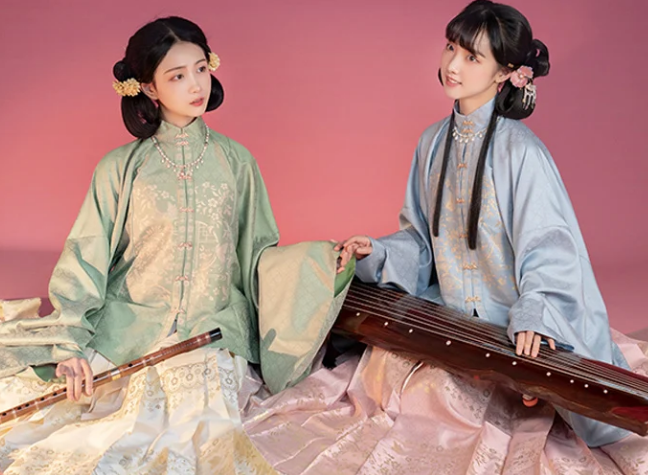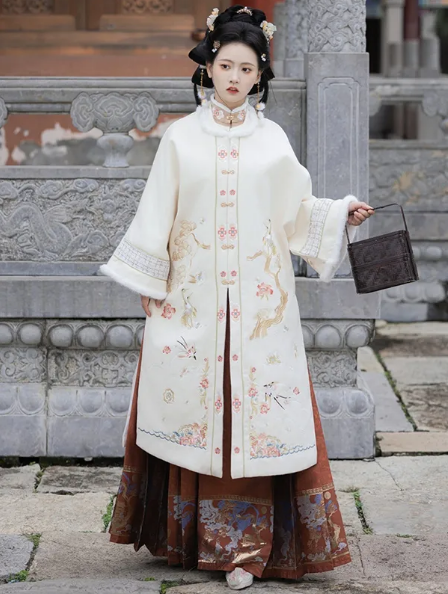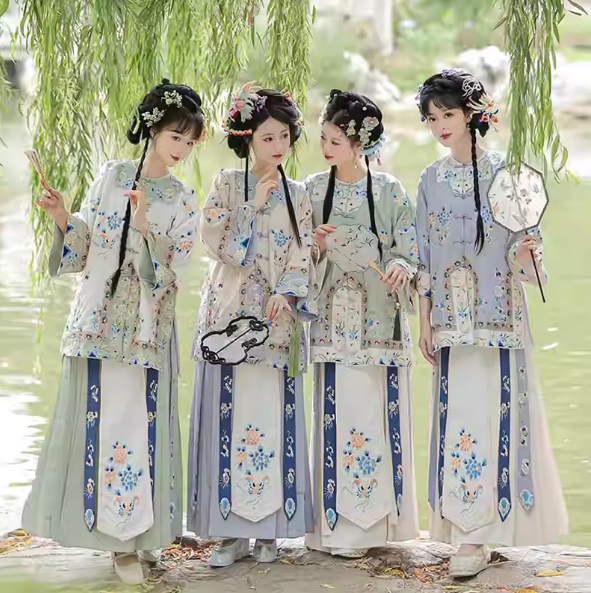Historical Context
The Ming (1368-1644) and Qing (1644-1912) dynasties mark significant periods in Chinese history, each with distinct cultural and societal norms. These eras, renowned for their rich traditions and elaborate clothing, showcase the evolution of Chinese attire and its deep connection with the country’s heritage.
Overview of Ming Dynasty
The Ming Dynasty, a period of cultural restoration and expansion, witnessed the consolidation of power and a strong emphasis on Confucian ideologies. During this era, clothing was a symbol of status and identity. Officials and the elite class wore elaborate robes with specific designs to signify their ranks. The common people, adhering to strict social norms, donned simpler garments. Men typically wore long robes, and women, influenced by the traditional Hanfu, adorned themselves with flowing dresses and intricate accessories.

Overview of Qing Dynasty
The Qing Dynasty, established by the Manchu people, introduced several changes to traditional Chinese clothing. This era saw the adoption of the Manchu-style ‘Qipao’ or ‘Cheongsam’, a form-fitting garment that later evolved into a symbol of Chinese femininity. The Qing rulers imposed strict clothing regulations to assert their dominance, mandating Manchu attire for officials and court members. The dragon robe, adorned with imperial symbols, became a quintessential representation of power. The common populace, while influenced by these styles, maintained a degree of traditional Ming clothing, creating a blend of styles and cultures.
In these dynasties, clothing was more than mere attire; it was a reflection of the social, political, and cultural landscapes. The fabrics, patterns, and designs of garments from the Ming and Qing periods offer a window into the rich tapestry of Chinese history and its enduring legacy.
Fabrics and Materials
In the grand tapestry of Chinese history, the Ming and Qing dynasties stand out for their distinctive use of fabrics and materials in clothing. These choices were not merely aesthetic but deeply rooted in available resources, technological advancements, and social customs of the times.
Common Fabrics in Ming Clothing
During the Ming Dynasty, silk held supreme status as the fabric of choice, especially for the upper class and royalty. Silk’s natural sheen and luxurious feel made it highly desirable, while its versatility allowed for various weaving techniques and patterns. Cotton, growing in popularity due to its comfort and ease of maintenance, became the go-to fabric for the common people. The Ming era also saw the use of other materials like hemp and wool, but these were less prevalent compared to the widespread use of silk and cotton.
Common Fabrics in Qing Clothing
The Qing Dynasty continued the silk tradition, with innovations in silk weaving leading to more intricate designs and textures. The Manchu rulers introduced new styles, incorporating their cultural influences into the fabric choices. Alongside silk, the use of fur became more prominent, reflecting the colder climate of the Manchu homeland. This period also saw an increased use of brocade, a richly decorative shuttle-woven fabric, often made with colored silks and sometimes with gold and silver threads. The common people, under economic constraints, largely wore garments made of more affordable fabrics like linen and coarse cotton.
These fabrics not only adorned the people of their time but also told stories of trade, innovation, and cultural exchange, leaving a legacy that continues to influence modern fashion and textile industries. The choice of materials in Ming and Qing clothing reveals much about the technological capabilities, economic conditions, and social structures of these dynastic periods.
Design and Style
The Ming and Qing dynasties showcased distinctive clothing styles that not only reflected the era’s fashion but also the societal values and norms. These styles, evolving through the centuries, offer a rich visual history of China’s past.
Ming Dynasty Clothing Styles
In the Ming Dynasty, clothing styles emphasized elegance and simplicity. Men typically wore long robes called “changpao” and a form of jacket over their robes. These garments often featured round collars and wide sleeves, embodying the Confucian ideals of modesty and restraint. Women’s clothing during the Ming era was equally refined, with the traditional “hanfu” being prevalent. This ensemble included a blouse and a wrap-around skirt or a one-piece dress, often complemented with intricate embroidery that depicted natural scenes or classical motifs. The attire was a clear indicator of social status, with the quality of fabric and complexity of designs increasing with the wearer’s rank.
Qing Dynasty Clothing Styles
The Qing Dynasty saw a significant shift in clothing styles with the rise of the Manchu rulers. The Manchu style, distinct from Han Chinese traditions, became prominent. Men and women both adopted the “Qipao” or “Cheongsam,” which evolved over time into a form-fitting dress for women. This garment, with its high collar and slits, represented a blend of traditional Chinese and Manchu fashion. The dragon robe, worn by the emperor and high-ranking officials, was another significant style of this era. It was a symbol of imperial power and featured intricate designs with dragons, which are culturally significant symbols in Chinese mythology. The Qing clothing styles reflected the political changes of the era and symbolized the Manchu influence over Chinese culture.
These clothing styles from the Ming and Qing periods illustrate the evolving nature of Chinese fashion, heavily influenced by cultural, political, and social changes. Each piece of attire, with its unique design and style, tells a story about the people and the times they lived in.
Color and Patterns
The Ming and Qing dynasties in China were not only times of political and social change but also eras of rich artistic expression, prominently seen in the use of colors and patterns in clothing. These elements were deeply symbolic and reflected various cultural, social, and even political nuances.
Significance of Colors in Ming Dynasty
During the Ming Dynasty, colors in clothing were a direct reflection of social status and imperial decrees. The royalty and high-ranking officials often adorned themselves in bright, vibrant colors, with yellow being exclusively reserved for the emperor, symbolizing his centrality in the universe. Red, associated with good fortune and joy, was popular in traditional Chinese weddings and festivals. Blue and green were common among the general populace, reflecting a connection with nature and a more modest standing. These color choices were deliberate and informed by Confucian values of order and hierarchy.

Significance of Colors in Qing Dynasty
In the Qing Dynasty, the significance of colors in clothing took on a new dimension with the Manchu influence. The imperial family continued the tradition of wearing yellow, although with different shades and textures to distinguish the Manchu rulers. The use of black, which represented stability and neutrality, became more prominent in official attire. Red maintained its significance, especially in court dresses and ceremonial clothing. The Qing era also saw an increased use of pastel shades and more subtle color combinations, reflecting the evolving aesthetic preferences of the time.
Patterns in both dynasties were equally significant, often featuring dragons, phoenixes, flowers, and other natural or mythological motifs, each carrying its own set of meanings and associations. The intricate designs not only showcased the artisans’ skills but also conveyed messages about the wearers’ identity and status. These colors and patterns are more than mere fashion choices; they are a vibrant language, narrating the rich tapestry of Chinese cultural heritage.
Influence of Social Hierarchy
The Ming and Qing dynasties in China vividly demonstrate how clothing was not just a matter of personal style, but a direct representation of social hierarchy. These historical periods reveal how fashion served as a visual demarcation of societal roles and status.
Clothing and Social Classes in Ming Era
In the Ming Dynasty, clothing distinctly reflected one’s social standing. The emperor, at the top of the hierarchy, exclusively wore yellow robes, signifying his unique position as the ‘Son of Heaven’. These imperial garments often featured dragon motifs, representing power and authority. Nobles and officials wore robes with specific insignia that denoted their ranks. Commoners, bound by law, wore simpler garments, usually in blue or green, made from materials like cotton or linen. Women’s attire varied significantly with social status, with elite women wearing elaborate silk gowns while commoners wore functional, less ornate dresses.
Clothing and Social Classes in Qing Era
The Qing Dynasty continued the tradition of clothing reflecting social hierarchy, but with distinct Manchu influences. The emperor’s attire remained elaborate, featuring dragon symbols on a yellow background. High-ranking officials wore robes with bird motifs, indicating their ranks and positions. The Manchu influence introduced the Changshan for men and the Qipao for women, which became widespread among the upper classes. For the general population, clothing was simpler and functional, often made from cheaper fabrics. The distinction in clothing styles between the ruling Manchus and the Han Chinese population was also a reflection of the socio-political landscape of the era.
In both dynasties, the intricate relationship between fashion and social hierarchy highlights how clothing served as a key indicator of one’s position within the societal structure, influencing and reflecting the cultural and political milieu of the times.

Cultural and Artistic Influence
The Ming and Qing dynasties in China were periods rich in cultural and artistic developments, which profoundly influenced the clothing styles of these eras. This influence is evident in the intricate designs, patterns, and choice of colors in the garments, reflecting the prevailing artistic sensibilities and cultural ethos.
Artistic Influences on Ming Clothing
During the Ming Dynasty, clothing styles were greatly influenced by the flourishing of arts and culture. The prevalent use of bright colors and intricate patterns in Ming attire was a reflection of the artistic renaissance of the period. Landscape and floral motifs, inspired by classical Chinese paintings, were common in silk embroidery. Calligraphy and poetry also found their way into clothing designs, with subtle inscriptions woven into the fabrics. The style and cut of Ming clothing, with its emphasis on flowing lines and elegant silhouettes, mirrored the contemporary artistic preference for grace and harmony.
Artistic Influences on Qing Clothing
In the Qing Dynasty, Manchu artistic tastes significantly influenced clothing styles. The introduction of new garment styles like the Qipao was a direct result of Manchu aesthetics, which favored straight lines and form-fitting shapes. Embroidery in Qing clothing often featured symbolic motifs such as dragons and phoenixes, drawing from Manchu folklore and art. The use of fur and other luxurious materials in clothing reflected the opulent art and decoration popular in the Qing court. Additionally, the integration of Han Chinese artistic elements with Manchu designs created a unique blend that defined the Qing fashion era.
In both dynasties, clothing was not merely a form of attire but a canvas for artistic expression. The evolving styles, patterns, and colors in Ming and Qing clothing offer a fascinating window into the cultural and artistic landscapes of these historical periods.







